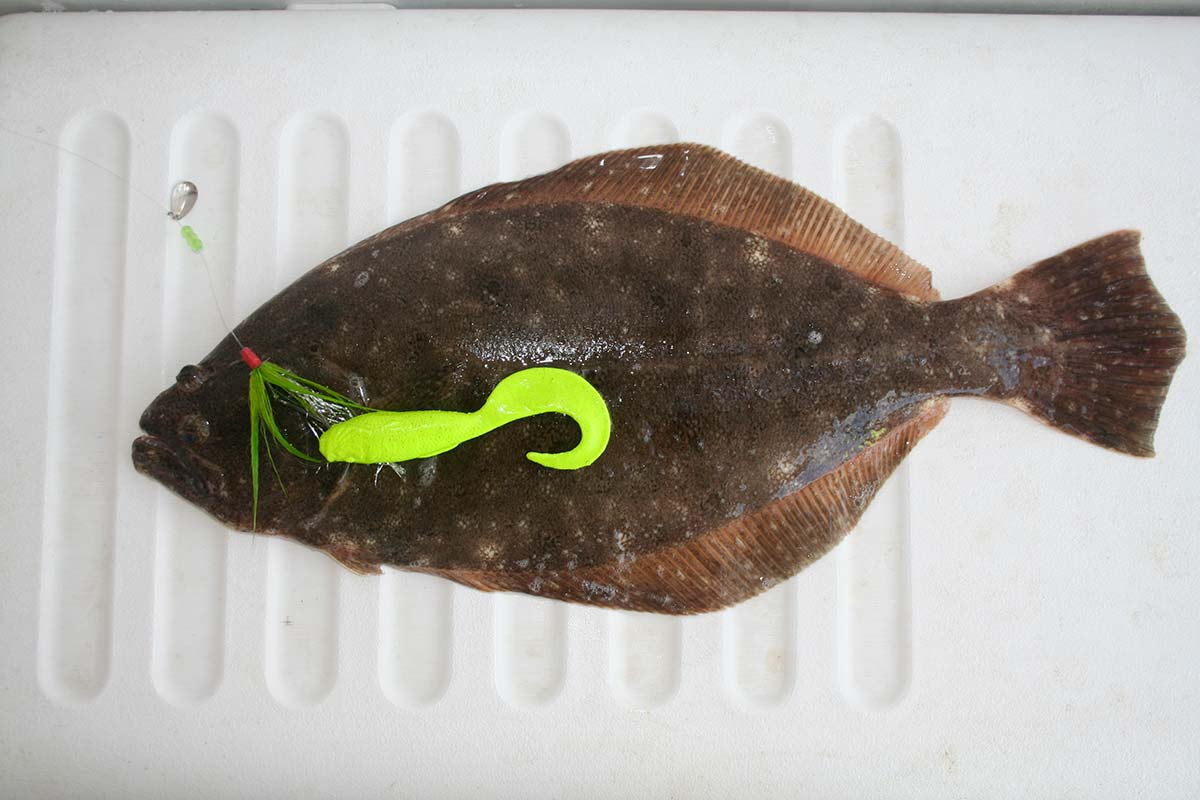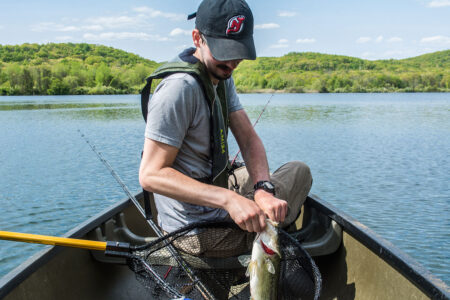
August is a great month to fish Delaware Bay out of Lewes. There are numerous species available and unless we get a hurricane, the weather is calm.
A few years ago, the Lewes boat ramp was moved from in town to a location much closer to Roosevelt Inlet. It lies at the end of Pilot Town Road and has ample parking for tow vehicles and trailers plus cars for those who may meet you at the ramp.
I like to get an early start, say around 6 a.m. Once underway, I will head for the Ferry Wall and fish in from almost to the beach to the end. I like to cast an unweighted minnow to the wall and let it swim around the rocks to see what sort of trouble it can find. Quite often, it finds a keeper summer flounder or two before we drift to the end of the wall.
Hit The Wall
There are a few holes around the end of the wall that will hold nice-sized croaker and spot in August. I will mark them on my SONAR and either drift across the schools or anchor up current and drift Gulp or Fishbites back to the schools. I do not fish inside the wall where the ferry approaches the dock. When crossing that piece of water I make sure no ferry is arriving or departing.
The area between the Ferry Wall and the fishing pier will often hold a variety of fish. I have caught croaker, spot, blues and trout just blind drifting there. Be sure to stay far from the pier so as not to interfere with those folks fishing from there. On the other side of the pier is an area of rolling bottom that can produce flounder at high tide. Drift across here so your favorite flounder offering goes up and down the hills. I am partial to a white bucktail with a white Gulp or a live minnow.
By now you are looking at the Inner Wall. The wind and current direction will determine how you will fish this piece of structure. I do use my electric trolling motor to make small corrections, but I don’t try to buck Mother Nature. As you might guess, there is a huge hole at the lighthouse end of the wall. I have never caught anything from the hole, but I have seen breaking bluefish in the turbulent water there.
I will normally work down the side of the wall looking for concentrations of fish on my SONAR and casting live minnows to the structure. One day I found a school of big spot at the inside of the wall that saved an otherwise water haul. To tell the truth, I have never had any luck on the outside of the Inner Wall, but that does not keep me from trying.

Outer Limits
Between the Inner and Outer walls is where the current runs in from the ocean to the bay. This creates a few rips and channels that can produce blues at times. Bottomfishing can be productive for flounder, but the strong currents can make that a difficult task.
Moving to the Outer Wall, let me begin by saying I do not toggle off. This is the process of anchoring a boat off of the wall, then coming back on the anchor rode until the stern is over productive bottom, then tossing a grappling hook into the rocks. You then come tight on both lines until you are much too close to the wall for comfort. This process is used primarily for tog fishing. I love a tog, but not that much. In the summer sheepshead and triggerfish may be caught here on sand fleas.
I fish the Outer Wall by casting plugs and bucktails to the rocks and working them back to the boat. This will produce blues and rockfish and this year I believe there is a good chance of a decent sized trout. A 7-pounder has already been taken here. This technique will work on either side of the wall, but I have had my best success on the oceanside.

There is a special season for striped bass (rockfish) in Delaware Bay and its tributaries from July 1 to August 31. You are allowed one fish between 20 and 25 inches. The most successful rockfish lure, in my experience, has been the Rebel Windcheater. Cast to the very edge of the rock wall and allowed to rest for a second or two before retrieving it back with a steady speed works for me. Give it a few strokes at the boat just in case a fish has been following.
| REEF SITE 8 |
| Concrete and steel 38° 51.892’ N / 75° 08.054 W
Golden Eagle 38° 52.080 N / 75° 08.094 W Concrete 38° 51.890 N / 75° 08.483 W Concrete 38° 52.163 N / 75° 08.409 W Concrete 38° 52.100 N / 75° 08.800 W Concrete 38° 52.220 N / 75° 09.065 W Concrete 38° 52 066 N / 75° 08 663 W Concrete 38° 51.749 N / 75° 08191 W Concrete 38° 52.356 N / 75° 09.350 W Complex Concrete 38° 52.389 N / 75° 09.505 W |
There is a rip that makes up on the north end of the Outer Wall that can produce almost anything or nothing. Drifting across the rip while working a bucktail with Gulp, a live minnow or a strip of squid or bluefish can produce bluefish, flounder or even a nice rockfish.
From the north end of the Outer Wall, you can see the last Ice Breaker. Drifting between these two structures can produce some very nice bottomfish. On occasion I have caught big northern kingfish here using Fishbites bloodworm on a top-bottom rig. The hot spot was closer to the Outer Wall than the Ice Breaker.
The Ice Breakers hold sheepshead and triggerfish and you toggle off of them the same way as the walls. Once again, I leave this to the more experienced captains. The Shears run from the Ice Breakers north and this shoal can hold bottomfish like croaker, spot and kings. I have caught all three at times, but not in great numbers. I find the best action is close to the structure where the current has carved out small holes around the Ice Breakers. Once again bloodworms, Fishbites, peeler crab and squid will be the top baits.
De Reef Sites
Moving up the bay you will find Reef Site 8. It was the original reef site called the Star Site Reef because STAR Enterprise donated concrete and steel to build the reef. It is 4.5 nautical miles from Roosevelt Inlet and I can easily make the run in my 16-foot tin boat.
In addition to the concrete and steel there is the 70-foot tug boat, Golden Eagle, all donated in 1996. Nine more donations of concrete we made between 1998 and 2011. Their locations are noted in the sidebar.
I fish here quite often, especially in the late summer. Like all of Delaware Bay, I find the reef sites fish best on incoming water. I try to pick a day when the tide will be high in the late morning so I can get out and back before any afternoon thunderstorms catch me 4.5 nautical miles from the launch ramp.

In August you can expect to catch anything from spot to sheepshead to croaker to triggerfish at this reef site. Drifting is the way most folks fish here, although you may find some that anchor. In that case, be alert that you don’t drift down on them.
I enter the LAT/LON numbers in my GPS and try to fish the structure using my electric trolling motor. The idea is to drift over the structure with the prevailing current so your bait or lure is presented to the fish laying on the down-current side.
If I am after sheepshead or triggerfish, I will use sand fleas. If kings, croaker or spot are the target, then bloodworms, Fishbites, peeler crab or squid will work. There are flounder on all these reef sites, but catching them is not easy. Years ago, I fished for flounder with the late, great Joe Walker. He had so many spots marked on his GPS only he could decipher where he was going.
We drifted Reef Site 8 and three of us caught a limit of flounder to, I would guess to about 5 pounds. As we were sitting under the shade of the canopy by the cleaning table at Lewes Harbour Marina watching the late Joe Morris filet our catch, another couple came up to have their one flounder cleaned. We saw them fishing the same area where we were. They complained about the poor fishing until they saw our pile of filets.
| DELAWARE REGULATIONS |
| In Delaware you are allowed to keep four summer flounder greater than 16 inches. The minimum size for croaker is 8 inches with no bag limit. Weakfish are still one fish per day at 13 inches.
Delaware does have a General Fishing License. It covers fishing, clamming and crabbing in Delaware waters. The cost is $8.50 for Delaware residents and $20.00 for non-residents. There is a 7-DayTourist Fishing License that cost $12.50. Learn more at dnrec.alpha.delaware.gov. |
My go-to rig for Delaware Bay flounder is the Delaware Bay Green Machine by Captain Mitchel Lures. This rig has been working for many years and when baited with a nice big minnow and a strip of squid, it is irresistible to a flounder. A white bucktail with a Gulp twister tail is a close second.
This year I hope to try a yellow bucktail with a purple worm, my go-to lure for trout back in the day. We are seeing more big trout this year than I have seen in a long time. Of course, a bucktail baited with peeler crab is another good trout bait.
I believe Delaware Bay may be returning to its glory days and Lewes is a great town to access the best of this fishing.



